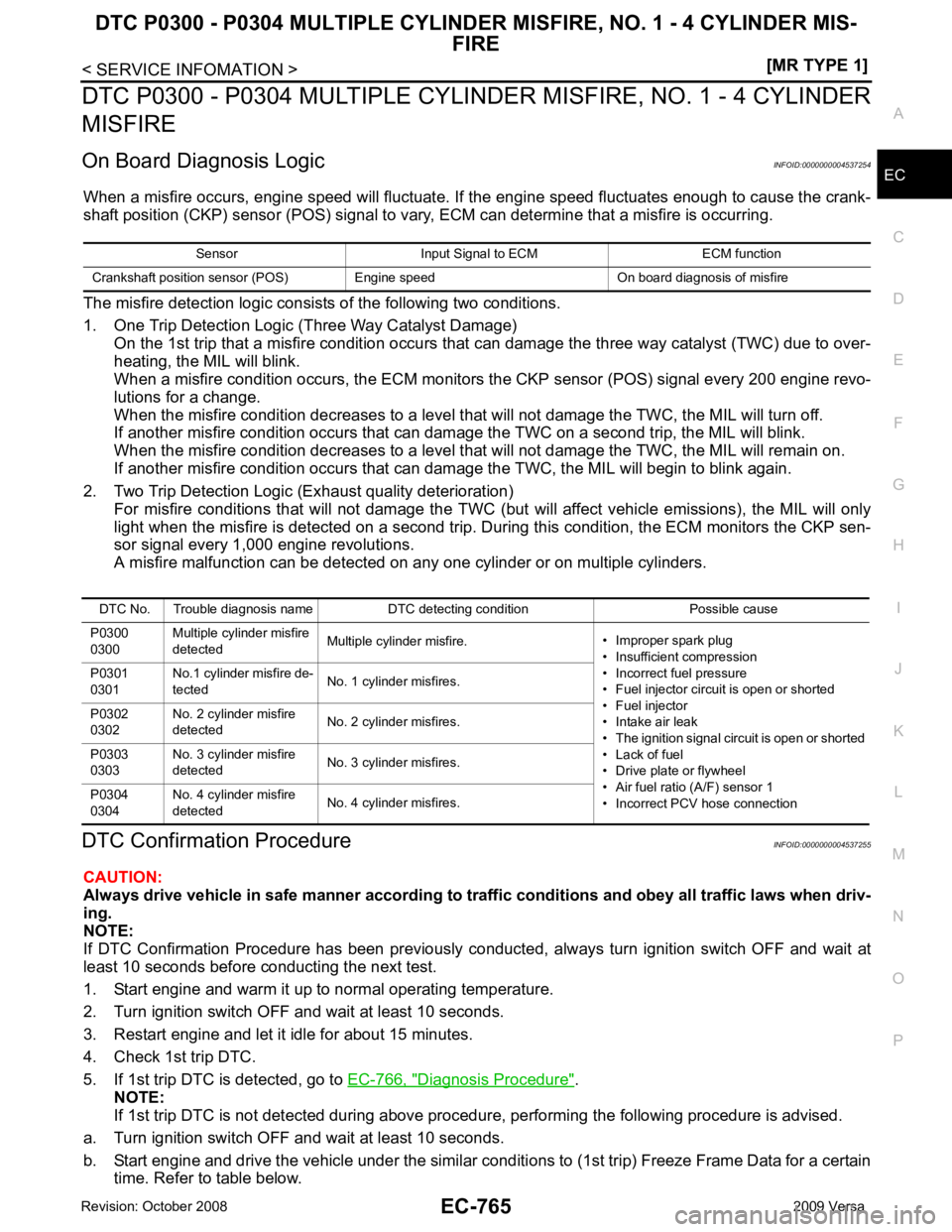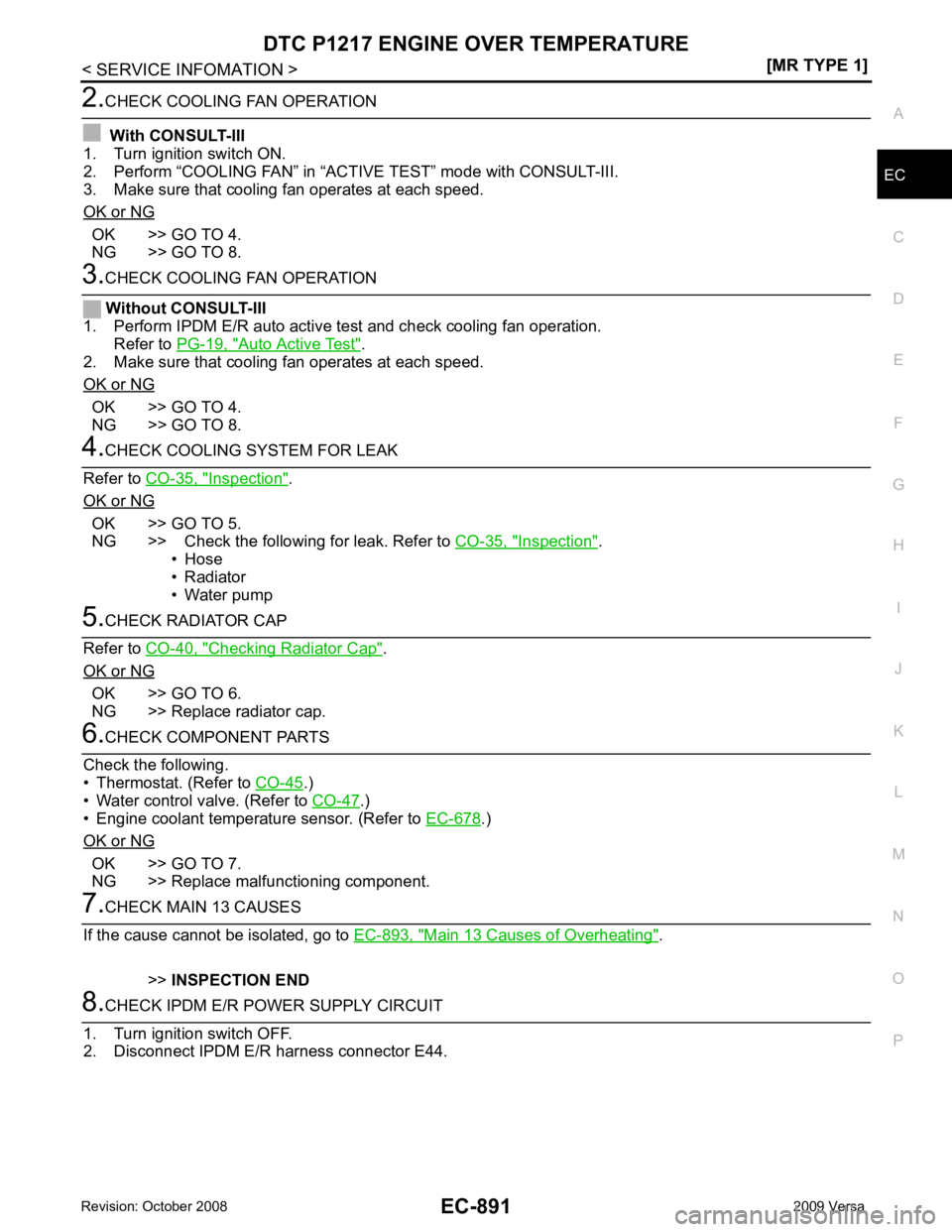2009 NISSAN LATIO heating
[x] Cancel search: heatingPage 1537 of 4331
![NISSAN LATIO 2009 Service Repair Manual P0128 THERMOSTAT FUNCTION
EC-181
< COMPONENT DIAGNOSIS >
[HR16DE] C
D E
F
G H
I
J
K L
M A EC
NP
O
Is the inspection result normal? YES >> GO TO 2.
NO >> Replace engine coolant temperature sensor. 2.
C NISSAN LATIO 2009 Service Repair Manual P0128 THERMOSTAT FUNCTION
EC-181
< COMPONENT DIAGNOSIS >
[HR16DE] C
D E
F
G H
I
J
K L
M A EC
NP
O
Is the inspection result normal? YES >> GO TO 2.
NO >> Replace engine coolant temperature sensor. 2.
C](/manual-img/5/57359/w960_57359-1536.png)
P0128 THERMOSTAT FUNCTION
EC-181
< COMPONENT DIAGNOSIS >
[HR16DE] C
D E
F
G H
I
J
K L
M A EC
NP
O
Is the inspection result normal? YES >> GO TO 2.
NO >> Replace engine coolant temperature sensor. 2.
CHECK THERMOSTAT
Refer to CO-23, " Inspection " .
Is the inspection result normal? YES >> INSPECTION END
NO >> Replace thermostat.
Component Inspection INFOID:00000000047801061.
CHECK ENGINE COOLANT TEMPERATURE SENSOR
1. Turn ignition switch OFF.
2. Disconnect engine coolant temperature sensor harness connector.
3. Remove engine coolant temperature sensor.
4. Check resistance between engine coolant temperature sensor terminals by heating with hot water as shown in the figure.
Is the inspection result normal? YES >> INSPECTION END
NO >> Replace engine coolant temperature sensor. Terminals Condition Resistance
1 and 2 Temperature [ °C ( °F)] 20 (68) 2.37 - 2.63 k
Ω
50 (122) 0.68 - 1.00 k Ω
90 (194) 0.236 - 0.260 k Ω PBIB2005E
Page 1604 of 4331
![NISSAN LATIO 2009 Service Repair Manual EC-248< COMPONENT DIAGNOSIS >
[HR16DE]
P0182, P0183
FTT SENSOR
>> INSPECTION END
Component Inspection INFOID:00000000047801461.
CHECK FUEL TANK TEMPERATURE SENSOR
1. Turn ignition switch OFF.
2. Disc NISSAN LATIO 2009 Service Repair Manual EC-248< COMPONENT DIAGNOSIS >
[HR16DE]
P0182, P0183
FTT SENSOR
>> INSPECTION END
Component Inspection INFOID:00000000047801461.
CHECK FUEL TANK TEMPERATURE SENSOR
1. Turn ignition switch OFF.
2. Disc](/manual-img/5/57359/w960_57359-1603.png)
EC-248< COMPONENT DIAGNOSIS >
[HR16DE]
P0182, P0183
FTT SENSOR
>> INSPECTION END
Component Inspection INFOID:00000000047801461.
CHECK FUEL TANK TEMPERATURE SENSOR
1. Turn ignition switch OFF.
2. Disconnect “fuel level sensor uni t and fuel pump” harness connector.
3. Remove fuel level sensor unit.
4. Check resistance between “fuel level sensor unit and fuel pump” terminals by heating with hot water as shown in the figure.
Is the inspection result normal? YES >> INSPECTION END
NO >> Replace “fuel level sensor unit and fuel pump”. Terminals Condition Resistance
4 and 5 Temperature [ °C ( °F)] 20 (68) 2.3 - 2.7 k
Ω
50 (122) 0.79 - 0.90 k Ω PBIB0931E
Page 1609 of 4331

EC
NP
O
P0300, P0301, P0302, P0303, P0304 MISFIRE
DTC Logic INFOID:0000000004780152
DTC DETECTION LOGIC When a misfire occurs, engine speed will fluctuate. If the engine speed fluctuates enough to cause the crank-
shaft position (CKP) sensor (POS) signal to vary , ECM can determine that a misfire is occurring.
The misfire detection logic consists of the following two conditions.
1. One Trip Detection Logic (Three Way Catalyst Damage) On the 1st trip , when a misfire condition occurs that can damage the three way catalyst (TWC) due to
overheating, the MIL will blink.
When a misfire condition occurs, the ECM monitors the CKP sensor signal every 200 engine revolutions
for a change.
When the misfire condition decreases to a level t hat will not damage the TWC, the MIL will turn off.
If another misfire condition occurs that can damage the TWC on a second trip, the MIL will blink.
When the misfire condition decreases to a level t hat will not damage the TWC, the MIL will remain on.
If another misfire condition occurs that can damage the TWC, the MIL will begin to blink again.
2. Two Trip Detection Logic (Exhaust quality deterioration) For misfire conditions that will not damage the TWC (but will affect vehicle emissions), the MIL will only
light when the misfire is detected on a second trip. Du ring this condition, the ECM monitors the CKP sen-
sor signal every 1,000 engine revolutions.
A misfire malfunction can be detected on any one cylinder or on multiple cylinders.
DTC CONFIRMATION PROCEDURE YES >> Go to
EC-254, " Diagnosis Procedure " .
NO >> GO TO 3. DTC No. Trouble diagnosis name DTC detecting condition Possible cause
P0300 Multiple cylinder misfire detected Multiple cylinders misfire. • Improper spark plug • Insufficient compression
• Incorrect fuel pressure
• The fuel injector circuit is open or shorted
• Fuel injector
• Intake air leak
• The ignition signal circuit is open or shorted
• Lack of fuel
• Signal plate
• A/F sensor 1
• Incorrect PCV hose connection
P0301 No.1 cylinder misfire detected No. 1 cylinder misfires.
P0302 No. 2 cylinder misfire detected No. 2 cylinder misfires.
P0303 No. 3 cylinder misfire detected No. 3 cylinder misfires.
P0304 No. 4 cylinder misfire detected No. 4 cylinder misfires.
Page 2111 of 4331
![NISSAN LATIO 2009 Service Repair Manual DTC P0181 FTT SENSOR
EC-755
< SERVICE INFOMATION >
[MR TYPE 1] C
D E
F
G H
I
J
K L
M A EC
NP
O
2. Disconnect combination meter harness connector.
3. Check harness continuity between “fuel level NISSAN LATIO 2009 Service Repair Manual DTC P0181 FTT SENSOR
EC-755
< SERVICE INFOMATION >
[MR TYPE 1] C
D E
F
G H
I
J
K L
M A EC
NP
O
2. Disconnect combination meter harness connector.
3. Check harness continuity between “fuel level](/manual-img/5/57359/w960_57359-2110.png)
DTC P0181 FTT SENSOR
EC-755
< SERVICE INFOMATION >
[MR TYPE 1] C
D E
F
G H
I
J
K L
M A EC
NP
O
2. Disconnect combination meter harness connector.
3. Check harness continuity between “fuel level sens or unit and fuel pump” terminal 5 and combination
meter terminal 24. Refer to Wiring Diagram.
4. Also check harness for short to ground and short to power.
OK or NG OK >> GO TO 6.
NG >> GO TO 5. 5.
DETECT MALFUNCTIONING PART
Check the following.
• Harness connectors B102, M13
• Harness for open or short between “fuel level sensor unit and fuel pump” and ground.
>> Repair open circuit or short to ground or short to power in harness or connectors. 6.
CHECK FUEL TANK TEMPERATURE SENSOR
Refer to, EC-755, " Component Inspection " .
OK or NG OK >> GO TO 7.
NG >> Replace “fuel level sensor unit and fuel pump”. 7.
CHECK INTERMITTENT INCIDENT
Perform EC-626 .
>> INSPECTION END
Component Inspection INFOID:0000000004537237
FUEL TANK TEMPERATURE SENSOR 1. Check resistance between “fuel level sensor unit and fuel pump” terminal 4 and 5 by heating with hot water as shown in the fig-
ure.
2. If NG, replace “fuel level sensor unit and fuel pump”.
Removal and Installation INFOID:0000000004537238
FUEL TANK TEMPERATURE SENSOR Refer to FL-5 .
Continuity should exist.
Temperature °C ( °F) Resistance k Ω
20 (68) 2.3 - 2.7
50 (122) 0.79 - 0.90 PBIB0931E
Page 2115 of 4331
![NISSAN LATIO 2009 Service Repair Manual DTC P0182, P0183 FTT SENSOR
EC-759
< SERVICE INFOMATION >
[MR TYPE 1] C
D E
F
G H
I
J
K L
M A EC
NP
O
4. Also check harness for short to ground and short to power.
OK or NG OK >> GO TO 6.
NG >> GO TO NISSAN LATIO 2009 Service Repair Manual DTC P0182, P0183 FTT SENSOR
EC-759
< SERVICE INFOMATION >
[MR TYPE 1] C
D E
F
G H
I
J
K L
M A EC
NP
O
4. Also check harness for short to ground and short to power.
OK or NG OK >> GO TO 6.
NG >> GO TO](/manual-img/5/57359/w960_57359-2114.png)
DTC P0182, P0183 FTT SENSOR
EC-759
< SERVICE INFOMATION >
[MR TYPE 1] C
D E
F
G H
I
J
K L
M A EC
NP
O
4. Also check harness for short to ground and short to power.
OK or NG OK >> GO TO 6.
NG >> GO TO 5. 5.
DETECT MALFUNCTIONING PART
Check the following.
• Harness connectors B102, M13
• Harness for open or short between “fuel level sensor unit and fuel pump” and ground
>> Repair open circuit or short to ground or short to power in harness or connector. 6.
CHECK FUEL TANK TEMPERATURE SENSOR
Refer to, EC-759, " Component Inspection " .
OK or NG OK >> GO TO 7.
NG >> Replace “fuel level sensor unit and fuel pump”. 7.
CHECK INTERMITTENT INCIDENT
Perform EC-626 .
>> INSPECTION END
Component Inspection INFOID:0000000004537244
FUEL TANK TEMPERATURE SENSOR 1. Check resistance between “fuel level sensor unit and fuel pump” terminal 4 and 5 by heating with hot water as shown in the fig-
ure.
2. If NG, replace “fuel level sensor unit and fuel pump”.
Removal and Installation INFOID:0000000004537245
FUEL TANK TEMPERATURE SENSOR Refer to FL-5 .
Continuity should exist.
Temperature °C ( °F) Resistance k Ω
20 (68) 2.3 - 2.7
50 (122) 0.79 - 0.90 PBIB0931E
Page 2121 of 4331

EC
NP
O
DTC P0300 - P0304 MULTIPLE CYLINDER
MISFIRE, NO. 1 - 4 CYLINDER
MISFIRE
On Board Diagnosis Logic INFOID:0000000004537254
When a misfire occurs, engine speed will fluctuate. If the engine speed fluctuates enough to cause the crank-
shaft position (CKP) sensor (POS) signal to vary , ECM can determine that a misfire is occurring.
The misfire detection logic consists of the following two conditions.
1. One Trip Detection Logic (Three Way Catalyst Damage) On the 1st trip that a misfire condition occurs that can damage the three way catalyst (TWC) due to over-
heating, the MIL will blink.
When a misfire condition occurs, the ECM monitors the CKP sensor (POS) signal every 200 engine revo-
lutions for a change.
When the misfire condition decreases to a level t hat will not damage the TWC, the MIL will turn off.
If another misfire condition occurs that can damage the TWC on a second trip, the MIL will blink.
When the misfire condition decreases to a level t hat will not damage the TWC, the MIL will remain on.
If another misfire condition occurs that can damage the TWC, the MIL will begin to blink again.
2. Two Trip Detection Logic (Exhaust quality deterioration) For misfire conditions that will not damage the TWC (but will affect vehicle emissions), the MIL will only
light when the misfire is detected on a second trip. Du ring this condition, the ECM monitors the CKP sen-
sor signal every 1,000 engine revolutions.
A misfire malfunction can be detected on any one cylinder or on multiple cylinders.
DTC Confirmation Procedure INFOID:0000000004537255
CAUTION:
Always drive vehicle in safe manner according to traf fic conditions and obey all traffic laws when driv-
ing.
NOTE:
If DTC Confirmation Procedure has been previously conduc ted, always turn ignition switch OFF and wait at
least 10 seconds before conducting the next test.
1. Start engine and warm it up to normal operating temperature.
2. Turn ignition switch OFF and wait at least 10 seconds.
3. Restart engine and let it idle for about 15 minutes.
4. Check 1st trip DTC.
5. If 1st trip DTC is detected, go to EC-766, " Diagnosis Procedure " .
NOTE:
If 1st trip DTC is not detected during above proc edure, performing the following procedure is advised.
a. Turn ignition switch OFF and wait at least 10 seconds.
b. Start engine and drive the vehicle under the similar conditi ons to (1st trip) Freeze Frame Data for a certain
time. Refer to table below. Sensor Input Signal to ECM ECM function
Crankshaft position sensor (POS) Engine speed On board diagnosis of misfire DTC No. Trouble diagnosis name DTC detecting condition Possible cause
P0300
0300 Multiple cylinder misfire
detected Multiple cylinder misfire.
• Improper spark plug
• Insufficient compression
• Incorrect fuel pressure
• Fuel injector circuit is open or shorted
• Fuel injector
• Intake air leak
• The ignition signal circuit is open or shorted
• Lack of fuel
• Drive plate or flywheel
• Air fuel ratio (A/F) sensor 1
• Incorrect PCV hose connection
P0301
0301 No.1 cylinder misfire de-
tected No. 1 cylinder misfires.
P0302
0302 No. 2 cylinder misfire
detected No. 2 cylinder misfires.
P0303
0303 No. 3 cylinder misfire
detected No. 3 cylinder misfires.
P0304
0304 No. 4 cylinder misfire
detected No. 4 cylinder misfires.
Page 2243 of 4331

EC
NP
O
Cooling Fan Relay Operation
The ECM controls cooling fan relays in the IPDM E/R through CAN communication line.
CONSULT-III Reference Val ue in Data Monitor Mode INFOID:0000000004537394
Specification data are reference values.
On Board Diagnosis Logic INFOID:0000000004537395
If the cooling fan or another component in the cooli ng system malfunctions, engine coolant temperature will
rise. When the engine coolant temperature reaches an abnormally high temperature condition, a malfunction
is indicated.
This self-diagnosis has the on e trip detection logic.
CAUTION:
When a malfunction is in dicated, be sure to replace the coolant. Refer to CO-35, " Changing Engine
Coolant " . Also, replace the engine oil. Refer to
LU-17, " Changing Engine Oil " .
1. Fill radiator with coolant up to specified level with a filling speed of 2 liters per minute. Be sure to
use coolant with the proper mixture ratio. Refer to MA-15, " Anti-freeze Coolant Mixture Ratio " .
2. After refilling coolant, run engine to ensure that no water-flow noise is emitted.
Overall Function Check INFOID:0000000004537396
Use this procedure to check the overall function of the cooling fan. During this check, a DTC might not be con-
firmed.
WARNING: Cooling fan speed
Cooling fan relay
1 2 3
Stop (OFF) OFF OFF OFF
Low (LOW) ON OFF OFF
High (HI) ON ON ON MONITOR ITEM CONDITION SPECIFICATION
AIR COND SIG • Engine: After warming up, idle
the engine Air conditioner switch: OFF OFF
Air conditioner switch: ON
(Compressor operates.) ON
COOLING FAN • Engine: After warming up, idle
the engine
• Air conditioner switch: OFF Engine coolant temperature: 97
°C
(207 °F) or less OFF
Engine coolant temperature: Between
98 °C (208 °F) and 99 °C (210 °F) LOW
Engine coolant temperature: 100 °C
(212 °F) or more HIGHDTC No. Trouble diagnosis name DTC detecting condition Possible cause
P1217
1217 Engine over temperature
(Overheat) • Cooling fan does not operate properly (Over-
heat).
• Cooling fan system does not operate properly (Overheat).
• Engine coolant was not added to the system using the proper filling method.
• Engine coolant is not within the specified
range. • Harness or connectors
(Cooling fan circuit is open or shorted.)
• Cooling fan
• IPDM E/R (Cooling fan relays)
• Radiator hose
• Radiator
• Reservoir tank
• Radiator cap
• Water pump
• Thermostat
• Water control valve
For more information, refer to EC-893, " Main 13 Causes of Overheating " .
Page 2247 of 4331

EC
NP
O OK >> GO TO 4.
NG >> GO TO 8. Auto Active Test " .
2. Make sure that cooling fan operates at each speed.
OK or NG OK >> GO TO 4.
NG >> GO TO 8. Inspection " .
OK or NG OK >> GO TO 5.
NG >> Check the following for leak. Refer to CO-35, " Inspection " .
• Hose
• Radiator
• Water pump Checking Radiator Cap " .
OK or NG OK >> GO TO 6.
NG >> Replace radiator cap. .)
• Water control valve. (Refer to CO-47 .)
• Engine coolant temperature sensor. (Refer to EC-678 .)
OK or NG OK >> GO TO 7.
NG >> Replace malfunctioning component. Main 13 Causes of Overheating " .
>> INSPECTION END